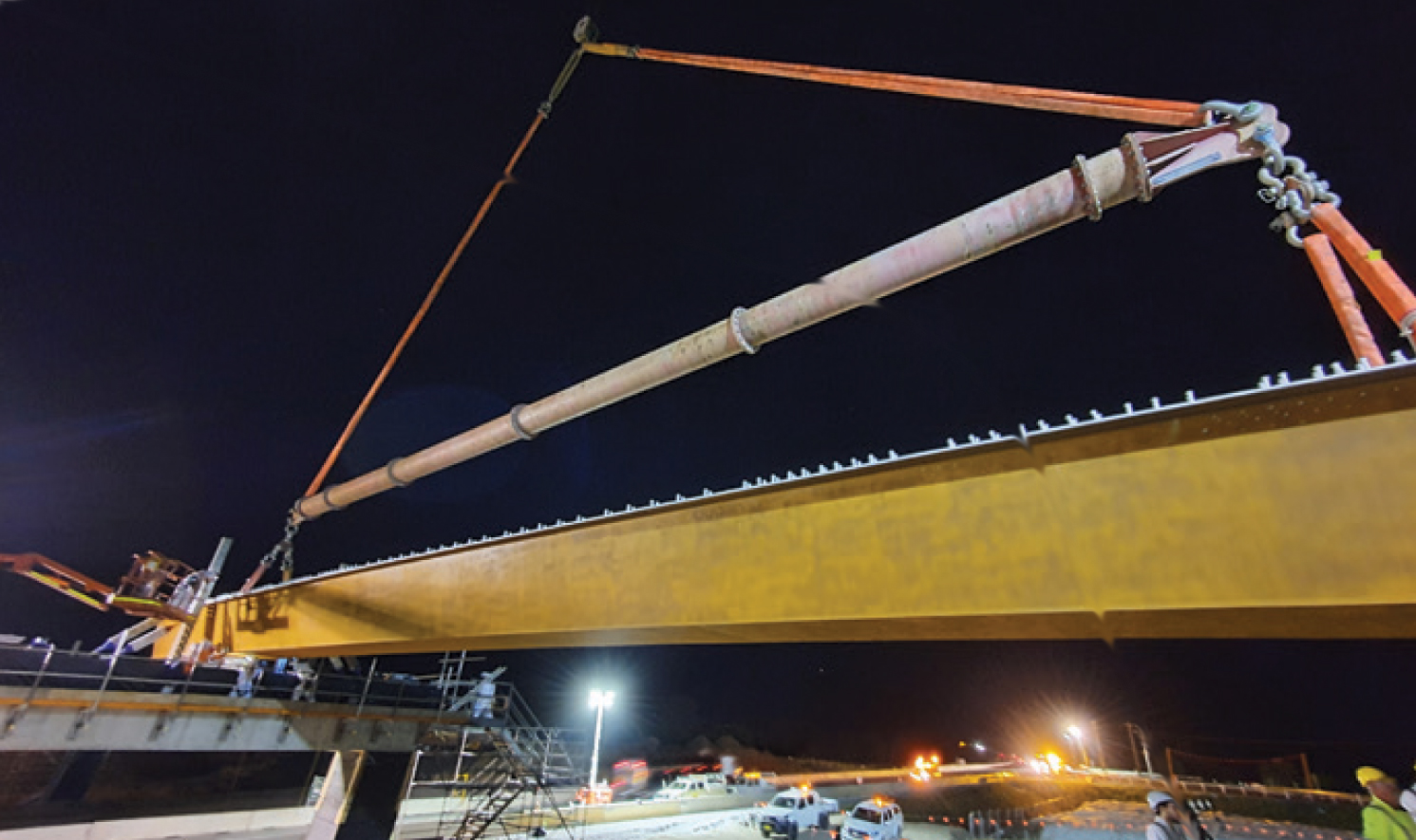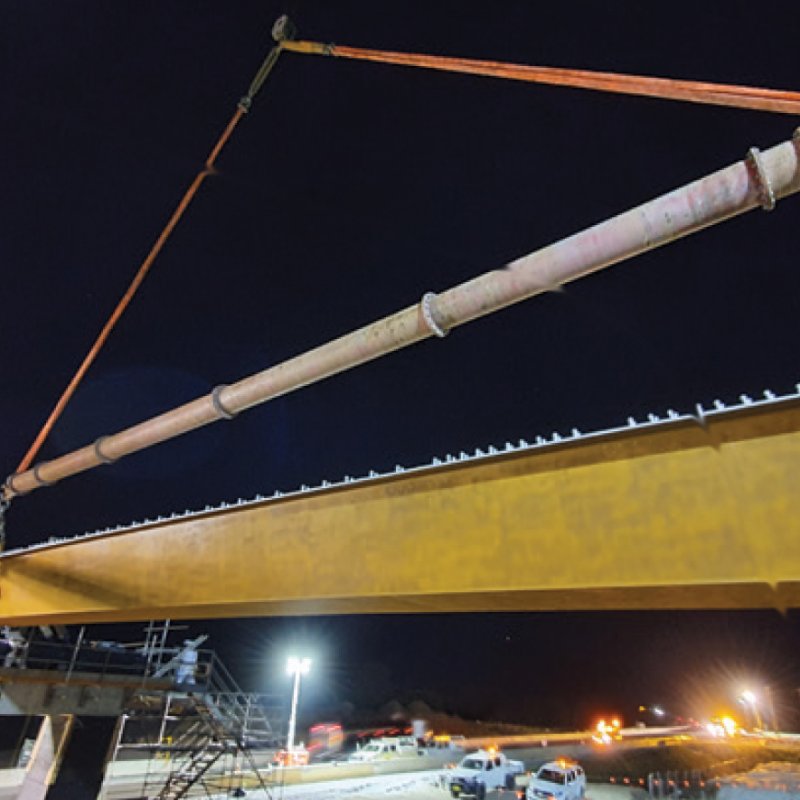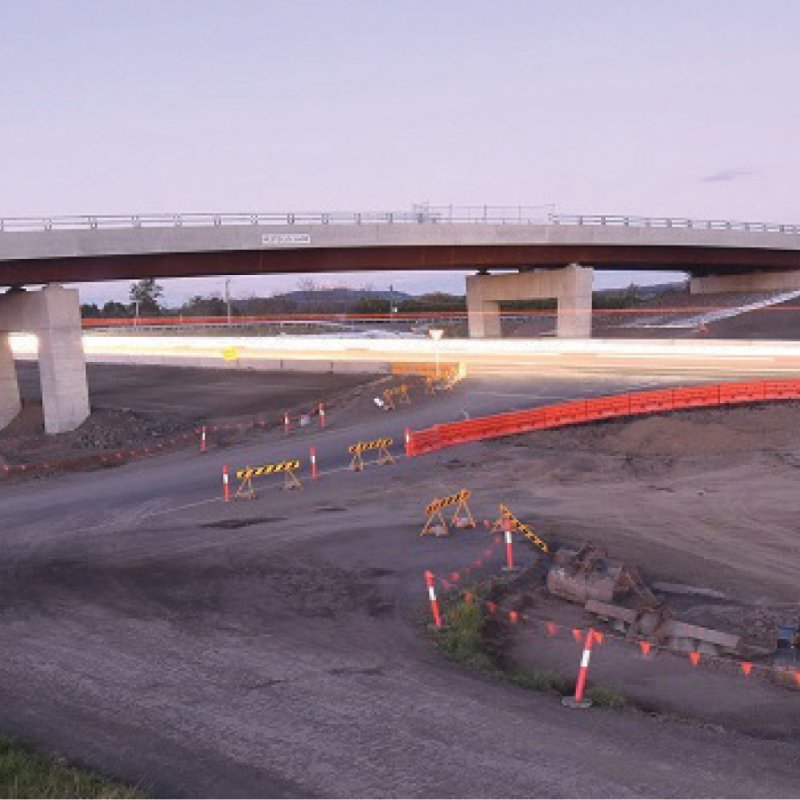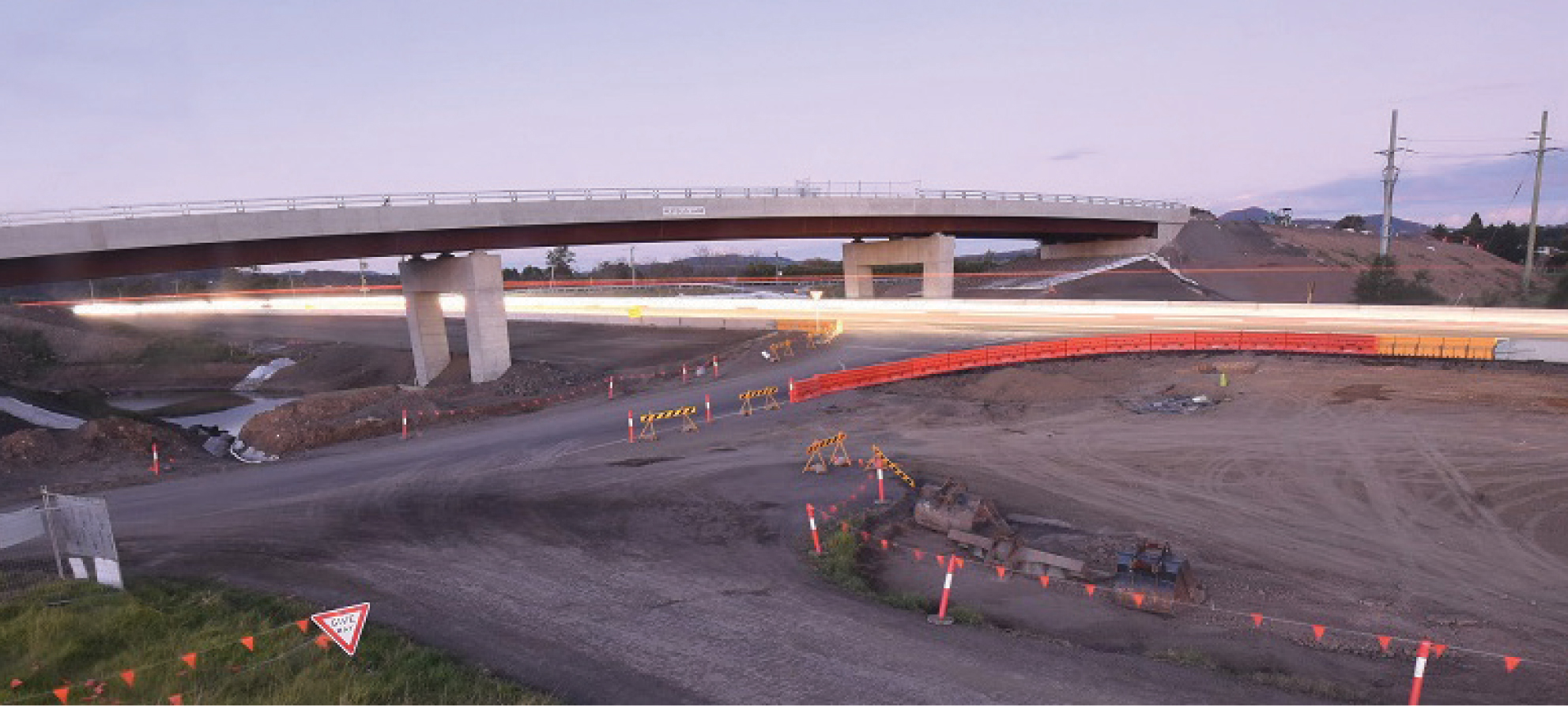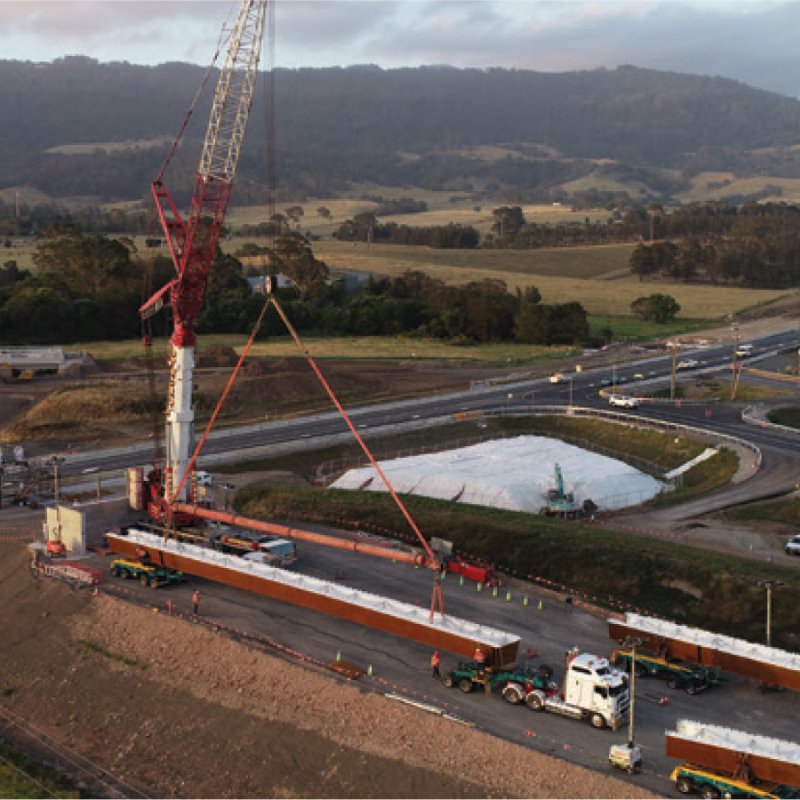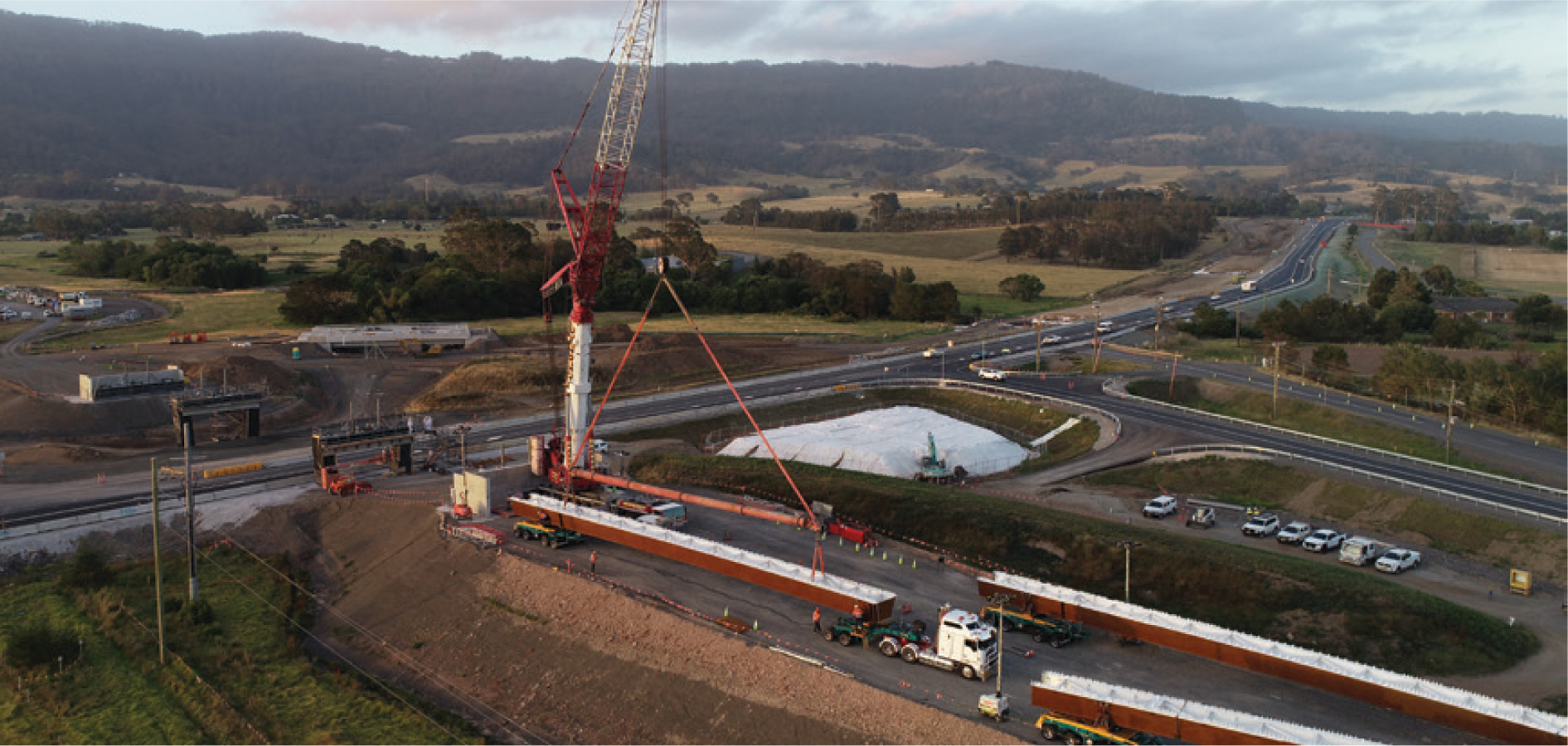Context: Designing bridges with weathering steel
Weathering steel has been used in bridge construction since the 1930s; it has been used extensively in North America, Europe and Japan for over 55 years and over the last 10 years in New Zealand.
Throughout the world, weathering steel has been widely adopted for bridges. It is estimated that up to 45% of steel bridges globally are constructed utilising some form of weathering steel1.
Notable international projects include the Bay Gateway Bridge in the United Kingdom (that connects Heysham to the M6 in Lancashire) which opened in 20162, and in New Zealand where its use in the Karapiro Gully Viaduct (part of the Waikato Expressway) is projected to deliver a design life of over 100 years3.
In Australia, the Berry to Bomaderry stretch of the Princes Highway on the NSW South Coast has seen two bridges constructed featuring long span trough girders manufactured from BlueScope's weathering steel which is known as REDCOR® weathering steel.
The value weathering steel can offer for bridge design internationally is echoed in the learnings from the NSW South Coast Princes Highway upgrades including key benefits in the constructability and maintenance solutions offered using BlueScope's REDCOR® weathering steel as explored throughout this case study.
What is BlueScope's REDCOR® weathering steel?
Weathering steel is a high strength, structural steel that, in suitable environments, develops a tightly adherent oxide layer or 'patina' which protects the steel – significantly reducing the corrosion rate compared with conventional uncoated structural steel.
REDCOR® weathering steel has durable surface protection properties making it suitable for structural applications, such as bridges, in appropriate environments. When exposed to normal climatic alternating wet and dry conditions, the colour of the patina forms and changes organically over time giving it a beautifully textured and unique identity.
Periodic inspection and cleaning should be the only maintenance required to ensure the bridge continues to perform satisfactorily4. As a protective coating is not normally required for REDCOR® weathering steel, the costs for inspection and occasional remedial treatment are usually considerably lower than other types of steel with different coating systems. Furthermore, the associated regular maintenance and typical mid-life recoating of these initial coating systems is avoided. Other indirect costs can also be greatly reduced such as those resulting from traffic management and traffic delay caused by providing site access while coating maintenance activities are carried out.
Weathering steel enhances the already robust sustainability credentials of steel. REDCOR® weathering steel has excellent circular economy credentials as its inherent properties allow it to be reused, remanufactured or recycled enabling its transformation into new products. Additionally, REDCOR® weathering steel used for bridges is prefabricated meaning minimal onsite waste.
REDCOR® weathering steel has been manufactured by BlueScope since the 1970s at BlueScope’s Port Kembla steelworks which is certified to the international environment management standard: ISO 14001:2015. 97% of the water used at the Port Kembla steelworks is either recycled or saltwater sourced from the ocean, reducing dependence on dam reserves.
The Project
A 10.6km stretch of the Princes Highway on the NSW South Coast, between Berry and Bomaderry, has recently enjoyed a $450 million upgrade.
Project Summary
This newly upgraded, four-lane section of road runs between Mullers Lane in Berry, and the Cambewarra Road roundabout in Bomaderry, and includes two composite bridges constructed using trough girders fabricated from BlueScope's REDCOR® weathering steel (with concrete decks).
The bridges are Strongs Road, Jaspers Brush which is a 55m long single-span bridge, and Pestells Lane, Meroo Meadow which is a 100m total span length (30+40+30), three-span bridge. Transport for NSW needed a solution that delivered rapid construction – particularly prompt erection, and engineering flexibility – for complex geometries, and to support long spans which can efficiently be achieved with steel girders.
Transport for NSW required that the proposed solution needed to achieve a maximum design life, with minimal environmental impact to the area, and minimal ongoing maintenance costs.
The bridge design incorporating BlueScope's REDCOR® weathering steel met these project goals which are explored in the full case study.
Material Selection
Early Planning
In the early planning stages one of the key decisions in the design was the choice of materials. According to Kumar Ponnampalam (Senior Bridge Engineer, Transport for NSW), a design using steel trough girders was the ideal solution for Transport for NSW to specify. As Mr Ponnampalam explained, "Steel enables faster construction, continuity in the girders, and structural efficiency. In the case of the Berry to Bomaderry project, steel was also beneficial due to the span arrangement."
Preliminary Design and Cost Estimate
Once steel girders had been selected as the key supporting structures for the two bridges, BlueScope supported Transport for NSW throughout the planning stages, assisting Mr Ponnampalam to build a sound business case for the use of steel, specifically weathering steel.
As part of this process, over twenty Transport for NSW stakeholders toured BlueScope's Port Kembla steel mill and production plant to learn more about the inherent benefits of using REDCOR® weathering steel. They also witnessed the steel manufacturing process coupled with BlueScope's strict quality control measures first-hand.
Furthermore, BlueScope contracted the Heavy Engineering Research Association (HERA) to develop guidance for design. The output of this work was the Design Guide for Weathering Steel Bridges in Australia.
Tender
With the design and detailing specifications confirmed, Transport for NSW specified the use of weathering steel for the two long-span bridges in the tender for the project.
Mr Ponnampalam was confident in specifying weathering steel. "I pushed for the use of weathering steel specifically because it does not require routine repainting or maintenance," he said.
Shaun Walsh (Project Manager, Transport for NSW) concurred. "A whole-of-life cost performance analysis identified that weathering steel would be a highly cost-effective, viable solution for these large span bridges."
Detailed Design and Engineering
Once REDCOR® weathering steel and the associated specifications were confirmed by Transport for NSW, Arcadis was engaged to undertake the architectural design and structural engineering. Arcadis is a structural design and consultancy firm for natural and built assets, employing 28,000 people, in over 70 countries. Arcadis is dedicated to improving quality of life through developing innovative solutions to create liveable cities.
According to Arcadis Project Manager, Jaco De Vry, "The use of prefabricated trough girder road bridge sections brought benefits to the project, particularly as an alternative to typical concrete 'Super T' construction. The trough girder sections allowed flexibility for longer spans and the skewed bridge geometry – there was an approximate 20 degree skew at Strongs Road, which required special detailing. Transport for NSW impose limitations for Concrete Super T bridges over 38m in length; they become uneconomical due to becoming extremely heavy making the transportation costs to site and installation of them much more expensive than standard Transport for NSW approved sizes, which is one of the reasons why Transport for NSW opted for steel girder construction on this project" said Mr De Vry.
According to Mr Walsh, one of the project objectives was to have no piers in the centre of the highway (between carriageways) and therefore the design solution had to cater for this. Thus Strongs Road is a single span, and Pestells a 100m total span length.
Arcadis' final design called for prefabricated trough girder road bridge sections, comprised of approximately 800 tonnes of BlueScope's REDCOR® weathering steel.
BlueScope supported Arcadis throughout the engineering process and their input did not go unnoticed."I'd happily work with BlueScope and REDCOR® weathering steel again. The supplier discussions during the design stage around specifications and preferred plate manufacturing thicknesses were very helpful," said Mr De Vry.
Fabrication and Installation
The bridges were constructed by Downer Seymour Whyte Joint Venture (DSWJV) who engaged Civmec to supply and deliver the steel girders for the project.
As a heavy engineering metal fabricator, highly experienced in the delivery of complex projects, Civmec has an annual fabrication capacity of up to 85,000 tonnes across their two state-of-the-art facilities in Perth and Newcastle.
According to Michael Tartaglia (Fabrication Manager, Civmec), the provision of quality project outcomes for clients is fundamental to Civmec, and one of the key reasons they were successful in winning the contract.
"Our quality management systems are certified to ISO 9001, the internationally recognised standard for quality management, and our facilities in Perth and Newcastle hold CC3 certification to the requirements of AS/NZS 5131 Structural steelwork – fabrication and erection," said Mr Tartaglia.
Commencing work in March 2019, Civmec undertook all fabrication and welding for six girders: three for the Pestells Lane Bridge, and three for the Strongs Road Bridge. The 1,400mm deep REDCOR® weathering steel trough at Pestells Lane required two site splices per girder, with segments at 27.5m and 36.8m in length. The 2,600mm deep REDCOR® weathering steel trough at Strongs Road required one site splice per girder, with segments at 14.6m and 40m in length.
"Welding REDCOR® weathering steel is no more onerous than any other high strength structural steel grades. It is covered by Australian Standards, such as AS/NZS 1554 Structural steel welding, so there is plenty of technical information readily available. I'd be very happy to work with REDCOR® weathering steel again; the weldability and fabrication is similar to the standard 350 carbon steels."
Michael Tartaglia - Fabrication Manager, Civmec
To maximise all the benefits offered by off-site fabrication, the bridges were fabricated in large pieces, and then transported to the sites approximately 300km away. The six girders measured up to 40m long and over 2m wide, and weighed approximately 50 tonnes each. As such, careful planning of transport and logistics was necessary to minimise disruption to motorists.
"Route surveys were completed and compiled in a Transport Management Plan," explained Mr Tartaglia. "Civmec liaised closely with DSWJV to plan the girders' arrival on-site on a specific day and time, so that there was no impact to the large crane mobilised on-site and minimal impact to traffic movements."
TOLL Heavy Haulage transported the girders in just two days. The girders left Civmec's Newcastle facilities between midnight and 1am – with a NSW Police escort – before stopping at the Hawkesbury for a few hours to minimise the risk of delays. The girders then arrived on-site by 7am where a crane unloaded each girder and lifted it into place.
David Cukalevski (Project Engineer, DSWJV) explained that all site construction works, including the erection of the girders, were performed by DSWJV.
We built the concrete sub-structures and bridge abutments at each end first, followed by the two piers between the abutments to help the bridge span the highway. All the temporary works had to be carefully designed and certified to ensure that when we landed the girders, they were stable prior to installation." He continued, "Once the girders were erected by DSWJV, Civmec provided a team to perform the on-site welding."
Maintenance
One of the key reasons that REDCOR® weathering steel was selected for this project was to minimise the long-term maintenance costs of the bridges. "The use of REDCOR® weathering steel on a project like this reduces the issues associated with maintenance dramatically – and not just from a cost perspective," said Mr De Vry. "For instance, if you're painting a live bridge, there are health and safety implications for working at heights, road closures need to be carefully planned, and so on. If you specify weathering steel, you eradicate all these issues."
He continued, "In terms of ongoing maintenance requirements, nominal inspection of patina formation and thickness will be required over the first 12 months or so, as opposed to the much more complicated ongoing maintenance regime associated with painted steel girders. With the inspections, there could still be road closures required to inspect the patina, but not to maintain it."
Key Benefits Delivered
The use of REDCOR® weathering steel for the two long-span bridges provided a multitude of advantages to the Transport for NSW South Coast Princes Highway Upgrade, and key stakeholders praised the many benefits of this solution.
Minimal Ongoing Maintenance for whole-of-life
According to Mr Ponnampalam, "Typically, steel bridges need repainting every 25 to 30 years as per Australian Standards. Weathering steel does not require repainting. All that it requires is inspection at certain periodic intervals to ensure the patina layer is properly formed and protecting the steel inside.4"
Mr Cukalevski is keen to work with REDCOR® weathering steel in the future. "We had no issues at all with the REDCOR® weathering steel – everything went quite smoothly. From our perspective, REDCOR® weathering steel was just as easy to work with as concrete during construction."
Maximum Design Life
The corrosion rate of weathering steel is so low, that trough girder road bridge sections fabricated from the unpainted material can achieve a 100 year design life 4,5.
Minimal Environmental Impact
Weathering steel enhances the already robust sustainability credentials of steel.
- REDCOR® weathering steel is produced in BlueScope's Port Kembla steelworks which is certified to the international environment management process standard: ISO 14001:2015.
- 97% of the water used at the Port Kembla steelworks is either recycled or saltwater from the ocean, reducing dependence on dam reserves.
- REDCOR® weathering steel has excellent circular economy credentials. Its inherent properties allow it to be reused, remanufactured or recycled enabling its transformation into new products.
- REDCOR® weathering steel for bridges is prefabricated meaning minimal onsite waste.
- Reduced waste from standard steel bridges due to paint removal and disposal
Aesthetics
The weathering steel patina will complement the natural landscape in which the bridges are located. REDCOR® weathering steel is known for its distinctive earthy and evolving appearance brought about as the patina develops over time. Once fully formed and weathered the patina nicely blends with the environment.
"The use of REDCOR® weathering steel definitely improved the urban design aspect of the bridges," said Mr De Vry.
Constructability
Mr Walsh said "We chose to use weathering steel for its constructability and safety in design (whole-of-life) benefits. The way the bridges had to be built and maintained over the existing highway meant we couldn't use cast-in-place concrete construction. A whole-of-life cost performance analysis identified that weathering steel would be a highly cost-effective viable solution for these large span bridges."
This was particularly important in this project, which was located on a site with little room for manoeuvring. Steel played an important role as the Strongs Road Bridge required a 55m span and the Pestells Lane Bridge required a 100m total span length (40m over the highway).
Put simply, one of the most important benefits of using steel is that it has a better strength to weight ratio than concrete girders resulting in a lighter structure. This means you can achieve longer spans in bridges based on steel trough girders and as a result, you can avoid the extra piers that would normally be required with concrete girders. The result achieved on the Berry to Bomaderry Princes Highway upgrade has seen savings on foundations and substructure costs coupled with a construction approach that was safer, faster and more cost effective, as well as reduced ongoing maintenance costs for the people of NSW.
End to End Supply chain capability
The capabilities across the whole supply chain, from concept through to Civmec, DSWJV and Transport for NSW, were essential to the on-time delivery of the project. According to Mr Tartaglia, "BlueScope supplied all weathering steel plate on time within a six to eight-week period. We had regular contact with the mill and distributor on forecast deliveries, which worked really well – it meant Civmec was able to quickly and easily plan all necessary resources. The whole process was very straightforward."
Success in the Princes Highway Upgrade
The Berry to Bomaderry upgrade of the Princes Highway demonstrates just how important the material selection is in the design stages of a project. Transport for NSW was able to deliver a successful project through consideration of REDCOR® weathering steel and research of the steel supply chain capability through to the specification of REDCOR® weathering steel.
Overall the design delivered longer spans and a lighter structure providing savings in foundation and substructure costs. The steel was pre-fabricated off-site in a controlled environment resulting in safety benefits. Importantly the specification of REDCOR® weathering steel provided a critical advantage in significant whole-of-life cost savings with its 100 year design life capability, periodic inspection and cleaning should be the only maintenance required4.
Mr Ponnampalam would be more than happy to draw upon the strengths of weathering steel in future projects, saying, "This is the first time Transport for NSW has used weathering steel for a road bridge. I would be recommending its use in future projects. A weathering steel solution provides continuous network operation and overcomes the need for expensive routine paint work".
Sources
- Kumar Ponnampalam, Senior Bridge Engineer, Transport for NSW
- Shaun Walsh, Project Manager, Transport for NSW
- David Cukalevski, Project Engineer, DSWJV
- Jaco De Vry, Project Manager, Arcadis
- Michael Tartaglia, Fabrication Manager, Civmec
References
- https://www.aisc.org/globalassets/modern-steel/archives/2012/03/2012v03_weathering_steel.pdf.
- https://www.bbc.com/news/uk-england-lancashire-37822609.
- https://www.nzta.govt.nz/ assets/Uploads/201505-poster-karapiro-gully-viaduct.pdf.
- When designed, detailed and fabricated in accordance with the HERA design guide.
- It is important to consider project location, marine influence, rain, design, and starting material thickness when determining the design life relevant to the project.
